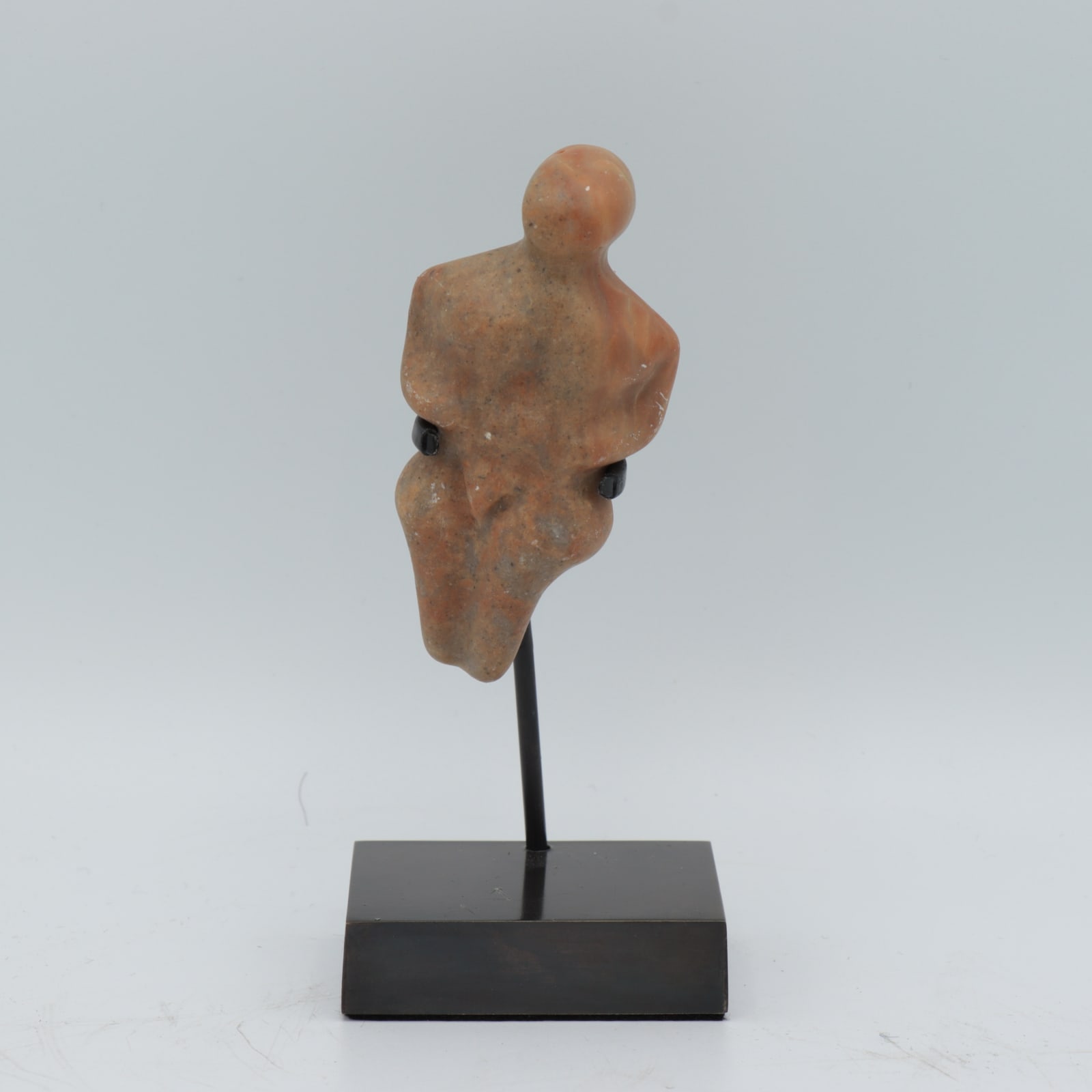Neolithic Anatolian 'Venus' Figure, 6000 BC - 5500 BC
Stone
7.5 x 3.7 x 1.7 cm
3 x 1 1/2 x 5/8 in
3 x 1 1/2 x 5/8 in
LI.2226
It is unknown what prompted human beings to first depict the world around them in artistic form. What is certain, given the time and energy pressures of food gathering, is...
It is unknown what prompted human beings to first depict the world around them in artistic form. What is certain, given the time and energy pressures of food gathering, is that art must have been considered important by the earliest peoples in order to have wasted time on it at all. Sat around the campfire, late at night, the artists of the Prehistoric used the most primitive tools imaginable to produce sensitive, elegant, even modernist, works of art. The first artworks so produced were animals; sculptures of mammoth and other prey came first, then some of the creatures which presented more of a risk to human beings, competing for space and resources. It took nearly 40,000 years for humans to begin depicting themselves consistently in sculptural form. These figures, misleadingly known as ‘Venus’ figures, on a strange analogy with the Roman goddess of love and beauty, were exclusively female. The only counter-example is not really of a human at all, but is rather the so-called löwenmensch (‘lion-man’), an anthropomorphised lion figure from Hohlenstein-Stadel in Germany. The purpose of ‘Venus’ figures is unknown; archaeologists usually suggest that they are fertility figures, on account of their oversized organs of generation and childrearing, but there is no evidence confirming this. Instead, it is possible that they were ritual implements used during the risky and painful process of childbirth, or else were gifts given to women at the time of their majority as part of a rite of passage into adulthood.
This beautifully-formed ‘Venus’ figure follows the usual Anatolian type. Her hips are broad, legs narrow, feet barely indicated. Her breasts and shoulders are similarly oversized, and her arms are brought together across her abdomen. Her form is an exaggerated hourglass figure, with a slender waist, neck, and legs. Her head is presented as a slightly under-proportioned knob on the top of the figure. This piece is incredibly tactile, clearly designed to be held comfortably in the hand. Given the fact that there was no way to display this figure standing up – the legs terminate in curved points – it is evident that this figure was designed to be held, laid down, or ritually disposed-of. One can imagine a pregnant woman holding such a figure about her person during the sensitive moment of childbirth. The later analogy of Biblical times indicates that such figures may have been carried about on a woman’s person, perhaps as an amulet or charm tied around the neck or upper arm.
The obsession of ancient peoples with the feminine form is not isolated; it stands at the start of an artistic tradition stretching from the first figural sculptures right to the present, through some of the most famous women in art history – the Girl with a Pearl Earring (), or Nude in a Red Chair (), for example – who have beguiled artists, creating works which are beautiful, striking, and oftentimes problematic. Art historians talk much these days about the ‘Male Gaze’, the unrelenting and questionable view of men which dominates our interpretation of women in art. We must imagine whether such a Male Gaze existed in the earliest times or not; are these ‘Venus’ figures reflecting a male view of female beauty? Or else are they something else entirely? Indeed, we cannot even indicate whether such figures were produced by male or female artists.
This beautifully-formed ‘Venus’ figure follows the usual Anatolian type. Her hips are broad, legs narrow, feet barely indicated. Her breasts and shoulders are similarly oversized, and her arms are brought together across her abdomen. Her form is an exaggerated hourglass figure, with a slender waist, neck, and legs. Her head is presented as a slightly under-proportioned knob on the top of the figure. This piece is incredibly tactile, clearly designed to be held comfortably in the hand. Given the fact that there was no way to display this figure standing up – the legs terminate in curved points – it is evident that this figure was designed to be held, laid down, or ritually disposed-of. One can imagine a pregnant woman holding such a figure about her person during the sensitive moment of childbirth. The later analogy of Biblical times indicates that such figures may have been carried about on a woman’s person, perhaps as an amulet or charm tied around the neck or upper arm.
The obsession of ancient peoples with the feminine form is not isolated; it stands at the start of an artistic tradition stretching from the first figural sculptures right to the present, through some of the most famous women in art history – the Girl with a Pearl Earring (), or Nude in a Red Chair (), for example – who have beguiled artists, creating works which are beautiful, striking, and oftentimes problematic. Art historians talk much these days about the ‘Male Gaze’, the unrelenting and questionable view of men which dominates our interpretation of women in art. We must imagine whether such a Male Gaze existed in the earliest times or not; are these ‘Venus’ figures reflecting a male view of female beauty? Or else are they something else entirely? Indeed, we cannot even indicate whether such figures were produced by male or female artists.
